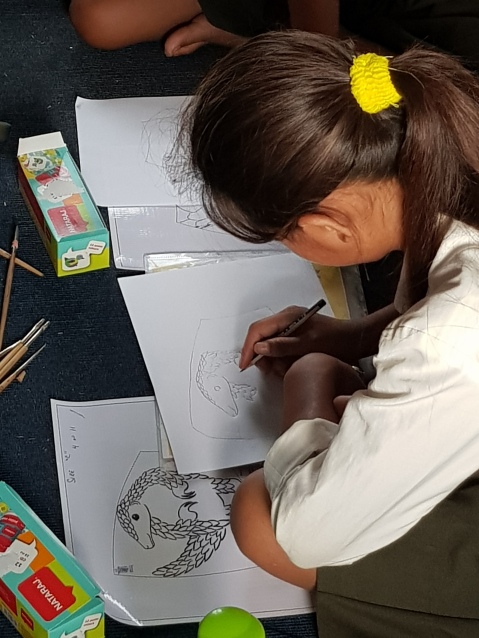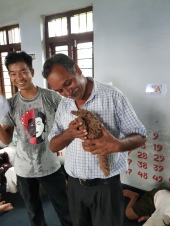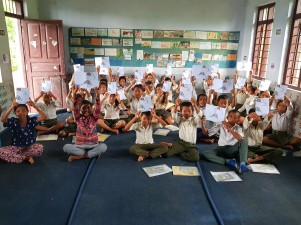Pangolin Education in Nepal
We wanted to share this amazing story with you from our friend and OMG Board Member Louise Fletcher who besides being our Asian pangolin expert, is also an accomplished artist and full time teacher in the UK, yet her passion for saving pangolins drivers her to take every free moment she can to travel to all corners of the earth to enlighten youth (and adults) about the beauty of the species and the need for all of us to get involved in saving them for future generations. The following is Louise’s write-up about the work she is doing right now in Nepal with our partner organization KYK Belt Project:
Unfortunately the goings on in Nepal sometimes remain out of the global eye. Less that a week ago the eastern part of Nepal suffered flash flooding causing homes to be destroyed, rice paddies flattened and landslides cutting off villages.
Yet, the village of Yangshila where KTK-Belt work have shown resilience and welcomed the start of their next education module based on pangolin conservation.
There are many challenges to overcome and today was the first trial run.
- Most of the students know nothing of a pangolin (which meant they left having discovered a lot of new knowledge)
- The obvious language barrier (for which I owe huge amounts to the local staff who helped facilitate the learning)
- Novel teaching methods (student led rather than teacher led, which took some getting used to)
- Uncomfortable conditions and lack of equipment (ridiculous heat and some a deafening downpour on an old tin roof)
However, there is nothing more satisfying than overcoming these barriers and finishing knowing students have left with a memorable experience.
To start with we used our new found friend Panga (follow on instagram @pangaforpangolins) to allow the students to introduce themselves and tell us if them or anyone in their family had ever seen pangolin.

After a quick quiz we talked about how animals have special features that help them adapt to their environment. The students then had to do card sort, matching the picture to the feature and thinking about how it helped the pangolin survive. This is a well used teaching method to get students thinking and discovering information, rather than just being told it, and this is not something that students are used to.

It took a little bit of convincing to show them that it didn’t matter if they got it right or wrong, but it was the process of thinking and discovery that was important. Remember, this convincing was done primarily through the medium of mime and smiling as my Nepalese is next to nothing.
They then began on their booklet, recording the features of the pangolin and drawing a picture of where they think a pangolin might live. It also took some support to help them realise they live in the forest and getting them to think about what might be in a forest.
We then moved on to looking at the fact that they are traded and used for medicine. students were shocked my images from Sumatra of nearly 1000 pangolins being buried after a warehouse of them being raided in Medan in 2015. They tackled some tricky maths to work out what pangolins were used for came up with solgans about what they would say to people to stop pangolins being used for medicine.
The final part of the workshop was campaign, run alongside One More Generation where students paint scales with images of pangolins on to a large banner, to pledge their protection to it. Students were free to colour the scales as they chose as a way to pledge their protection of the pangolin. I have never seen a group of students so focused on what they were doing. As I write the scales are drying and will be placed tomorrow on the banner, which will hopefully be displayed later in the village.

Grassroots education may not be easy or glamorous, but it certainly has impact.
To learn more about all of Louise’s amazing work, check out her blog here:
Sunda pangolin conservation



